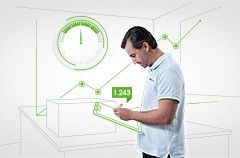We support and service your measurement equipment through its entire life-cycle, from installation to preventive maintenance and calibration to equipment repair.

Analytical Transmitters
High-Performance Transmitters for Reliable In-Line Analytics
Analytical transmitters are the component within a measurement system that communicates displayed measurements to a user or higher level control system. METTLER TOLEDO provides analytical transmitters for a wide range of analytics, including pH/ORP, oxygen, dissolved carbon dioxide and conductivity or resistivity. Our high-performance analytical transmitters offer compatibility with traditional analog sensors and digital sensors with Intelligent Sensor Management (ISM).
Explore our Services - Tailored to Fit your Equipment

Remote Support
Fast intervention and full security with our remote support capabilities.
- On-Site Customer with Mobile Device
- Remote Technician on Computer
Support & Repair

Maintenance & Optimization

Calibration & Quality

Training & Consulting

FAQs - Analytical Transmitters
What is an analytical transmitter?
Analytical transmitters are a critical component of an analytical measurement loop or control loop. A transmitter processes the measurement from an analytical sensor and communicates that data to a user or to a higher level control system.
What measurement parameters are covered by a METTLER TOLEDO analytical transmitter?
METTLER TOLEDO offers a range of multi-parameter transmitters (also called multi-variable transmitters) that cover all important parameters for process and water analytics, including measurement of pH, ORP (redox), dissolved oxygen (DO), resistivity, total organic carbon (TOC), dissolved ozone, CO2, oxygen, ozone, conductivity and turbidity.
How does an analytical transmitter work?
Most analytical transmitters measure the raw signal from an analytical sensor (depending on the sensor this can be pressure, current or resistance) and convert it into a digital signal, so that the measurement can be shown on the transmitter display. That is the standard process for an analog sensor and transmitter combination. Modern in-line transmitters also integrate with digital sensors, such as ISM sensors, where the signal is converted to digital before it is sent to the transmitter. With digital sensors, the transmitter primarily acts as a display, interpreting the digital data into useable information for the operator, or relaying that data to other information systems.
Can an analytical transmitter measure multiple parameters at the same time?
Yes, analytical transmitters that measure multiple parameters at the same time are called multi-parameter, multi-channel transmitters. This category of transmitters is optimal for situations where multiple parameters need to be measured, but a multi-channel transmitter can also be used when you need a redundant measurement for compliance purposes. Some multi-parameter transmitters can also provide calculated measurements, such as calculated pH based on conductivity. Multi-parameter transmitters in the METTLER TOLEDO portfolio can display up to eight measurements at a time.
Do analytical transmitters communicate by Ethernet/IP?
Yes, METTLER TOLEDO analytical transmitters offer all common digital communication protocols, including Ethernet/IP, Profinet, HART, Profibus-PA, FOUNDATION Fieldbus.
How do I select the right analytical transmitter?
There are a wide range of criteria that go into selecting an analytical transmitter. When considering your application, you should assess if you need to measure only one parameter with the transmitter, or will need to measure multiple parameters. If you need to measure multiple parameters, consider a multi-parameter transmitter. With a multi-parameter transmitter, you can use the same model transmitter for different parameters. If you need the transmitter to measure more than one measurement point simultaneously, you will need a multi-channel transmitter. You should also consider if you need this analytical transmitter to be integrated into a control system. If you want to use the predictive diagnostics of an ISM sensor, you will need an analytical transmitter that accepts ISM sensors. You should also consider the production environment. METTLER TOLEDO offers analytical transmitters with different enclosures, and that work in hazardous areas. Other things to consider are data capture abilities and ease-of-use. METTLER TOLEDO recommends a discussion with a local sales representative to assess your needs and recommend the right analytical transmitter for your specific application.



